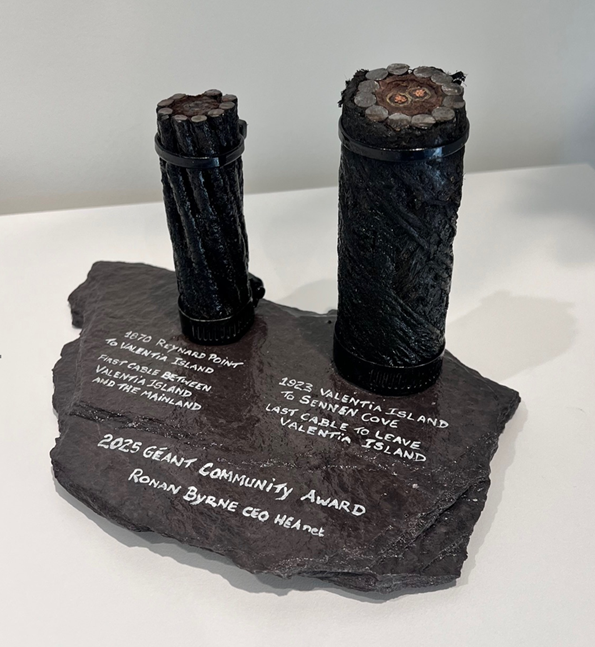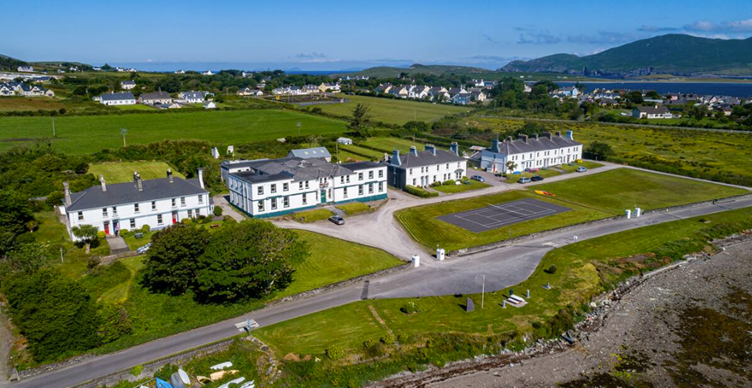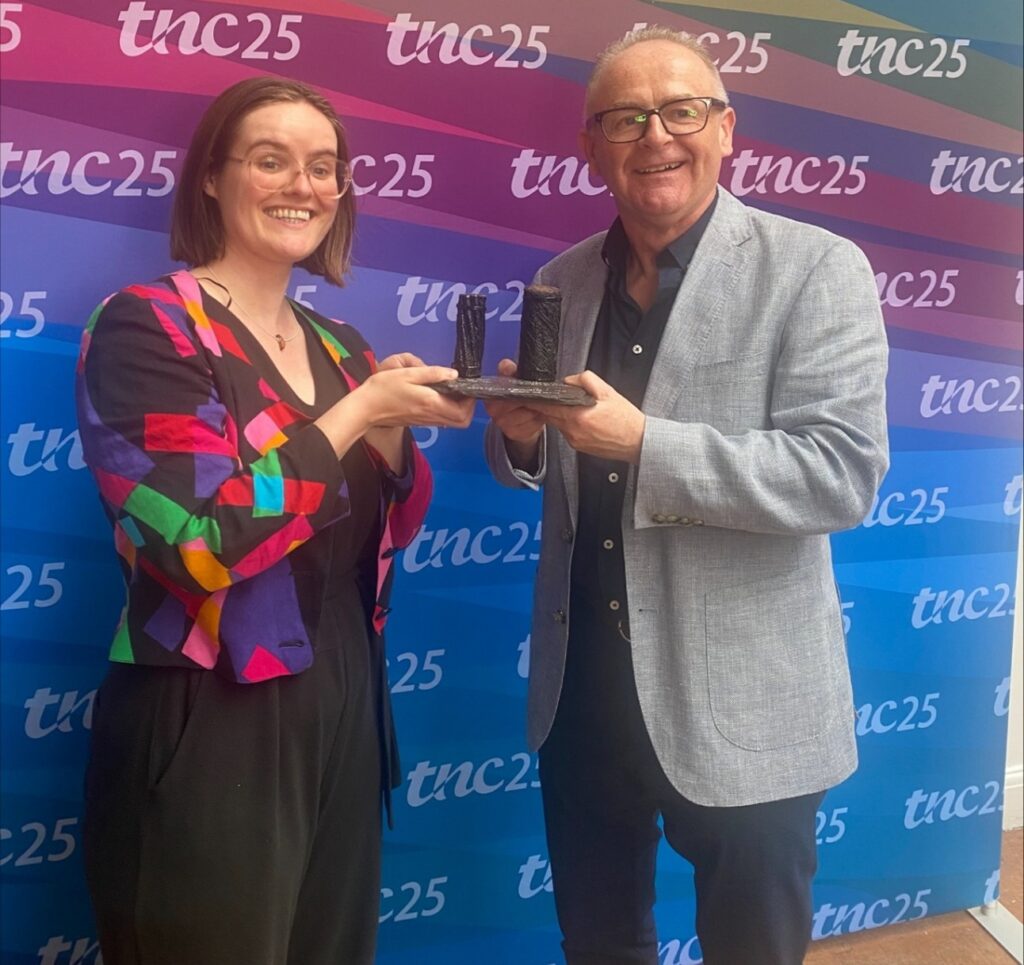A GÉANT Award Rooted in Ireland’s Communications Legacy
At this year’s prestigious TNC25 conference, HEAnet CEO, Ronan Byrne was honoured with the GÉANT Community Award, recognising his outstanding leadership and contribution to the European research and education networking community. But beyond the global significance of this accolade lies a uniquely Irish story, one that spans centuries of innovation, craftsmanship, and communication.
The award presented to Ronan was no ordinary award, it is a custom-made piece of history, steeped in Irish heritage, and extraordinary significance. Hand-crafted from the very cables that once carried the first transatlantic messages between Ireland, the U.S. and the U.K. It stands as a powerful symbol, marking a pivotal leap forward, in connecting nations and shaping the future of international communications.
The award was commissioned by GÉANT and designed and built by Derek Cassidy. Derek is a submarine cable historian, a technology specialist and avid supporter of the Valentia Island Cable Museum, which is often referred to as the Eighth Wonder of the World. Derek works closely with the Valentia Foundation and the Newfoundland Heritage Department, playing an active role in the Valentia Island World Heritage Bid. He is a dedicated advocate for preserving and promoting all aspects of our rich communication heritage.

A Tale of Two Cables
Embedded within the award are two historical submarine telegraph cables, each with their own extraordinary legacy. Both cables, now retired, connected Valentia Island in County Kerry to the wider world. Their lifespan was remarkable: each served reliably for 96 years, a testament to 19th and early 20thcentury engineering.
These cables were technical marvels of their time, constructed with: Stranded copper cores to transmit morse code, gutta-percha insulation to safeguard signals underwater, hemp fibre for structure and strength, steel armouring for durability, and protective coatings of grease or bitumen to preserve the metalwork from the harsh marine environment.
The 1870 Valentia Island to Cahersiveen telegraph cable was the first permanent telegraph connection between the mainland and the island. Other cables did exist, but they were temporary and only single core telegraph cables with no armouring. The 1870 cable is a 4-core telegraph submarine cable; it is capable of duplex transmission where two cores are for transmitting and two cores for receiving morse code. This cable was in constant use for almost a century until 1966 when the Valentia Island Cable Station closed. The telephone had arrived in the early 1960’s but the telegraph cable was still very popular with constant telegrams from all over Ireland and the world. The cable is no longer in place as it was recovered in the 1990’s for recycling. It was the longest serving telegraph submarine cable in the world with an operational life span of 96 years.
The 1923 Valentia Island to Sennen Cove, Cornwall, submarine telegraph cable was the last cable to leave Valentia Island and the third cable to connect to Sennen Cove. It was a 3-core telegraph submarine cable when leaving the cable station, the 3rd core was an earth connection while the other two cores were for traffic. The sample here is the deep-sea section from the Celtic Sea with two traffic cores. The earth core had a length of 20Kms only. This cable operated from 1923 to 1966.
The deep-sea section of this cable, incorporated in the award, once bridged Ireland and the UK across the Celtic Sea. Like its predecessor, it carried the hum of human connection, a tangible reminder of the messages, emotions, and decisions it once enabled between nations.

Valentia: A Global Communications Landmark
The cables originated from the Valentia Island Cable Station, built in 1868, which replaced the original 1857 telegraph hut at the Royal Hotel slate yard. The station is now the oldest surviving submarine cable building still in use in the world and plays host to the “Eighth Wonder” Transatlantic Cable Experience, a museum and event space that tells the story of Ireland’s leadership in transatlantic communication.
This legacy is not only remembered but actively championed. Valentia Island’s cable history and its architectural landmarks are part of Ireland’s tentative list for UNESCO World Heritage status, with a decision anticipated by 2029.
Slate with Global Standing
The award also incorporates Valentia Slate; a material as distinguished as the cables it accompanies. Quarried since 1816, this slate is known for its purity and strength. It has graced iconic sites such as the Paris Opera House, the US Library of Congress, UK House of Commons, and the British Library. In 2024, it was officially designated a World Heritage Stone by the International Union of Geological Sciences. There are only 55 of these worldwide and the only other Irish example of this designation is Connemara Marble. The slate is used today in exclusive developments, it is quarried to order, and is highly sought after across the globe.
A Fitting Tribute: Celebrating HEAnet’s Role in Global Communications
This award is more than a recognition of achievement; it is also a reminder of Ireland’s enduring legacy in global communication. Formed from the very materials that once connected continents, it honours both the past and the future of international collaboration, innovation, and human connection. This iconic award represents not only HEAnet’s impact on modern digital infrastructure, but also Ireland’s foundational role in the evolution of global communications.
Strategic Investment in subsea cable connectivity today is essential to secure Ireland’s global digital future.
History demonstrates the transformative value of timely investment in critical infrastructure. To safeguard Ireland’s position as a securely connected nation we must continue to prioritise and accelerate strategic investment in subsea cable connectivity. As Ireland’s national education and research network, HEAnet plays a pivotal role in enabling this vision, ensuring that our academic, research and innovative sectors remain at the forefront of global collaboration. Expanding this vital network today is essential to ensuring Ireland’s resilience, competitiveness and seamless integration with the global digital economy.

